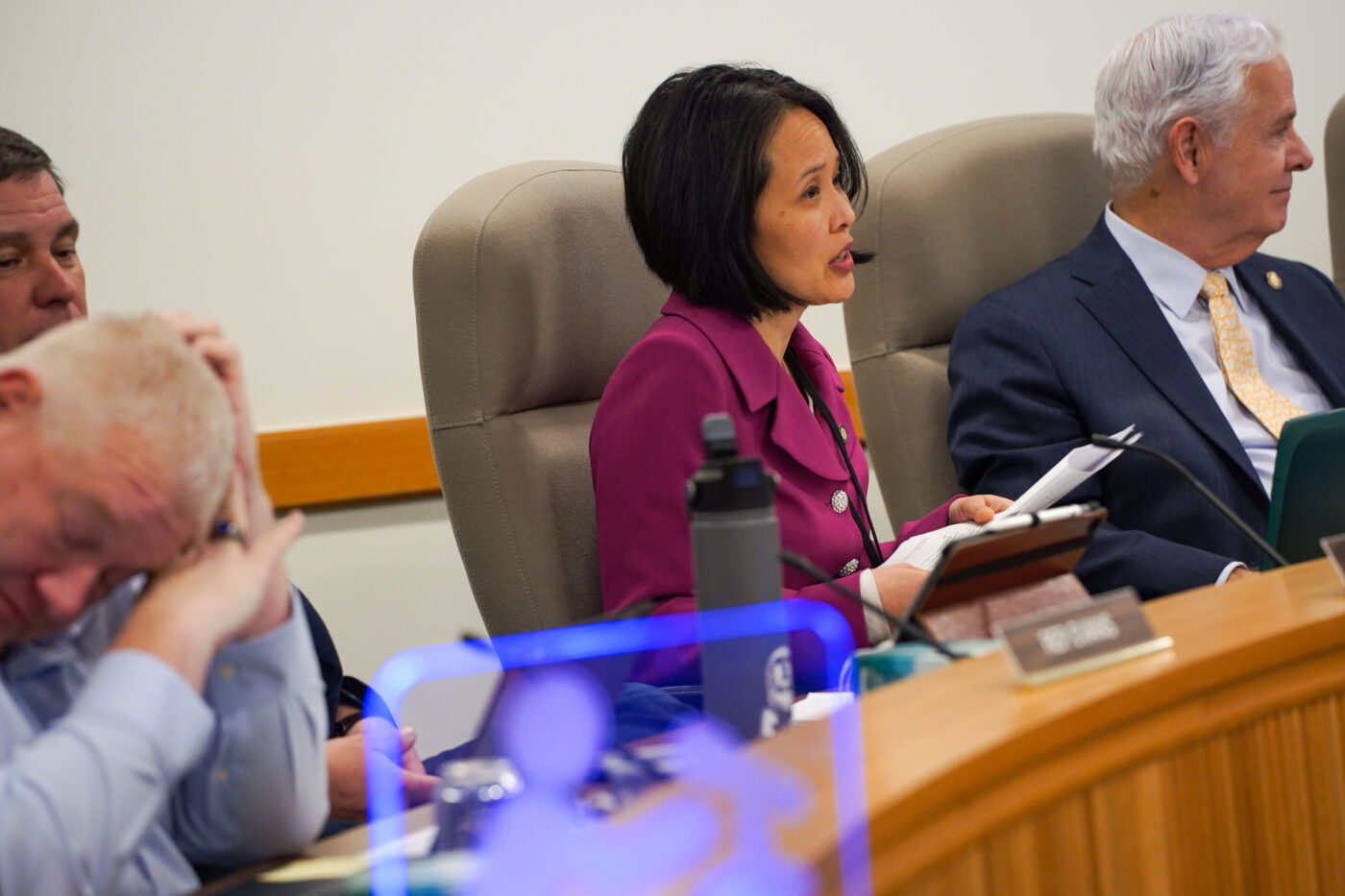

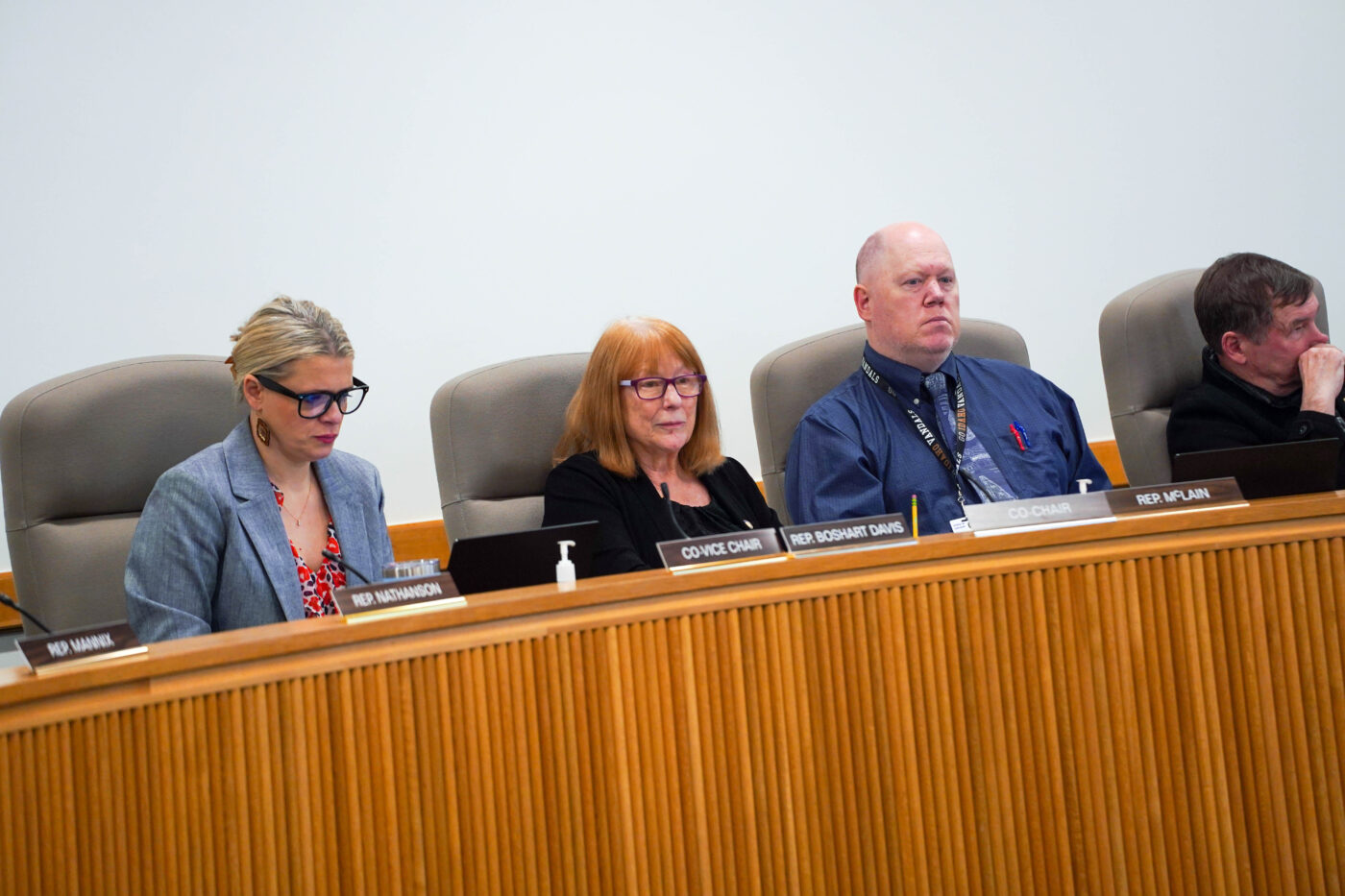
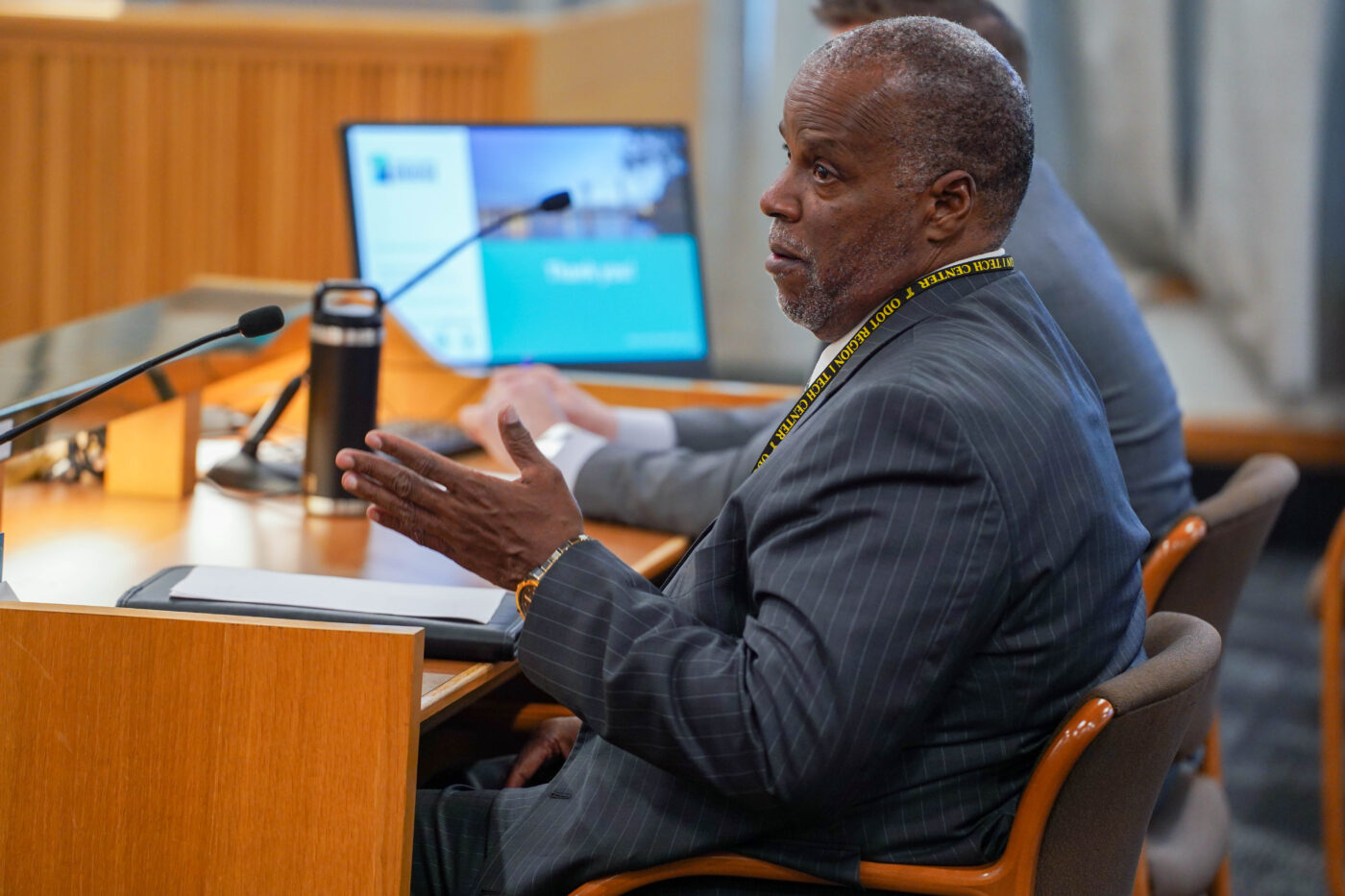
A group of five lawmakers who sit on the Joint Committee on Transportation (JCT) dropped a bombshell of a bill last week that seeks to come up with Oregon’s share of funding for the Interstate Bridge Replacement Program. That project (estimated to cost between $6 and $7.5 billion would replace the I-5 bridge between Portland and Vancouver, and build seven new interchanges with auxiliary lanes between them for a five-mile stretch of the freeway.
Everyone knew the debate over how to pay this $1 billion expense was coming since we got a preview at the end of March. But the actual bill wasn’t released until April 12th, and it just happened to get its first public airing the following day — at the tail end of a lobby day organized by the Just Crossing Alliance, a coalition of nonprofits that wants to “right-size” the project. I was at the State Capitol for that event and was able to attend the JCT’s informational session. While there wasn’t a robust debate because no public testimony was taken and JCT members only invited highly supportive panelists, we still heard the outlines of the debate to come.
Before I share a few of the meeting’s exchanges, let’s take a closer look at what’s in the bill.
The bill
HB 2098 -2 (PDF) is a classic “gut and stuff” which means it was filed months ago with a summary that said it would deal with speed bump heights and markings. That’s all been deleted and the “dash 2” amendments are what folks are talking about now.
There are several key things this bill wants to do. First, it would set a hard cap on the total price of the project at $6.3 billion. This is likely a gesture from lawmakers who want to be seen as holding ODOT accountable. When I asked a source (and ODOT critic) about why this was in the bill, they grinned and said, “What happens if they go over it? There’s no way to enforce it.”
The main meat of the bill is in Section 3 (page four, line nine) where it says the legislature will, “support the Interstate 5 bridge replacement project through an investment of $1 billion, financed through the issuance of general obligation bonds over the next four biennia and repaid with General Fund obligations.” It’s notable that when JCT members revealed their $1 billion plan at the end of March they asked to use only $300 million from GO bonds.
And then the bill starts to creep…
On page seven, line 16 there’s a section that would force the legislature to “fully fund” the I-5 Rose Quarter project in the next two sessions. The section also seeks to give I-5 Rose Quarter project a pat on the head by re-stating that it, “remains a priority project of statewide significance.” It’s unclear why JCT members threw this in, but the controversy and deep skepticism surrounding that project and the increasing desperation from ODOT to fund it (and several other freeway expansions in the region) likely has something to do with it.
Tolls will be a part of this project. In a section on cost analysis, the bill requires the legislature to “evaluate the amount that users of each class of vehicle actually paid for the cost of maintenance, operation and improvement of highways, roads and streets in the state; and whether the amount paid was a proportionate share of those costs.” This passage has some concerned that lawmakers want to be able to consider the possibility of tolling bike riders, electric car drivers, and so on.
Relatedly, also in the bill is new reporting that would be required as part of a “Highway Cost Allocation Study.” This study would seek to determine, “The proportionate share that the users of each class of vehicle should pay for the costs of maintenance, operation and improvement of the highways, roads and streets in the state; and whether the users of each class are paying that share.”
This morning at a Metro advisory committee meeting, the director of ODOT’s Urban Mobility Office, Brendan Finn, pointed out that the bicycle and pedestrian components of the IBR project cost about $100 million. If you pass a bill that defines a bicycle path as a “tollway” and then you have a study that says bicycle users are not paying their share of that $100 million, who knows what kind of policy conclusions lawmakers might come to.
Remember, several leaders of the JCT were the folks at the table when Oregon passed the $15 excise tax on the purchase of new bicycles.
The politics
Less than 24 hours after its first meeting at the JCT, Governor Tina Kotek threw cold water on the entire bill. According to the Capitol Chronicle, “She balked at the proposed source of those funds.”
It’s totally reasonable that the idea of using General Fund monies to pay for transportation projects gives Kotek some heartburn. According to economist and staunch ODOT critic Joe Cortright, HB 2098 is the first time in Oregon state history that would ever been done (I told you they are desperate). The state typically uses only the State Highway Fund to pay for road projects. “This would be a massive break from that philosophy,” Cortright wrote Tuesday. “It’s really hard to understand why Oregon taxpayers should take money that could be used to educate children, care for the sick, or address homelessness, and use it to subsidize commuters (and shoppers) from another state.”
At the JCT meeting last Thursday, House Representative Khanh Pham (D-Portland) expressed strong concerns about how the bill goes beyond just funding the IBR project. “I don’t quite understand why we’re bundling language about studies on tolling, funding the Rose Quarter — there’s even language about potentially tolling bicycle paths and singling out electric vehicles for special fees statewide…. I’m concerned,” she said.
Senator Lynn Findley, a Republic who represents eastern Oregon, reminded IBR Administrator Greg Johnson that he’s not comfortable with the fact that the legislature hasn’t voted to support funding this project. “We have to be very careful how we say [we got unanimous support from local officials for the project], none of this panel has voted for this bridge. There’s a difference between a local elected official saying ‘Yeah we love the bridge and this is the option we want,’ and not writing a check. And then the state people saying, ‘Yeah, we like the bridge and we’re going to write you a check.'”
Rep Pham also pressed Johnson for details about how wide the bridge would be and she questioned ODOT’s track record of using only 30% unionized labor on their construction projects.
The JCT is set to continue their debate on this bill at their meeting today. And this time they’ve invited a more diverse panel of voices that aren’t as likely to sing the project’s praises. Stay tuned for more coverage.
In related news, Senator Lew Frederick (D-Portland) has been named as a Joint Committee on Transportation co-chair. Sen. Frederick is taking the place of Sen. Chris Gorsek (D-Troutdale) who is away from the legislature due to a medical issue. I-5 runs through Sen. Frederick’s north Portland district.
UPDATE, 4/21: A public hearing for this bill has been set. It will be 4/27 at the JCT. Details here.


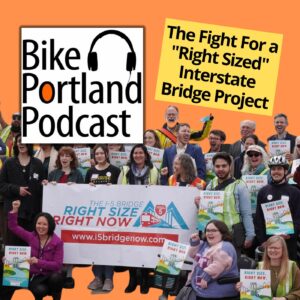

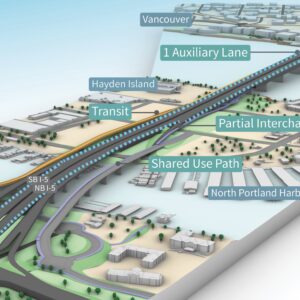
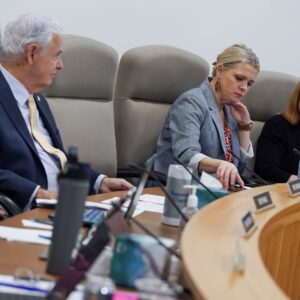
Thanks for reading.
BikePortland has served this community with independent community journalism since 2005. We rely on subscriptions from readers like you to survive. Your financial support is vital in keeping this valuable resource alive and well.
Please subscribe today to strengthen and expand our work.
Let’s say the bridge will cost $5B (most unlikely), then $100M is 2%. So if the toll for cars is $5 (just a guess), then the cost for bikes should be 10¢. Looking at the fare list posted at the tolls, some might realize what a great deal biking is. $100M is a huge number, until you realize that $5-10 billion is so much more.
Modern tolling is all license plate based. So it will be impossible to toll pedestrians and cyclists, unless they put in a staffed toll booth on the MUP, which would be legitimately insane.
Of course, this means the tolling cameras will also miss all of the stolen cars going back and forth across the river every day.
It shouldn’t be that difficult. Just have a closed access to the bike/pedestrian path that requires a pass to enter. Something similar to the Hop bus pass. Maybe skip the long winding ramps that will be needed to get up the 116 feet to bridge and have a bank of elevators that whisk bikes and pedestrians to the path entrance.
Terrific coverage! Mark Twain warned you not to witness sausage or legislation being made, but you are doing it and providing a great service to us all.
It is CRITICAL that GO (general obligation) bonding NOT be used for this project. It will encumber generations of Oregonians with expenses that will eat into their ability to pay for services we don’t even know we need yet. This huge boondoggle of a highway project can use the funds set aside for it – and nothing more.
It’s time for responsible leaders and legislators (Kotek, Dembrow, etc) to step up and point this bill in the right direction.
yes, this is exactly how cities and states go broke
https://youtu.be/7IsMeKl-Sv0
Of course they want to toll bicyclists, pedestrians, car drivers and anything imaginable. Tolling has only one goal and that is an opportunity to raise money for the general/slush fund. The arguments I’ve seen in support of tolling always fail as they never seem to appreciate this. Tolling isn’t to soothe or calm traffic, prevent single occupancy suv trips or punish out of staters….This is Oregon politics at its purest and it’s all about a grift wrapped in progressive/environmental values.
The Brooklyn bridge, the Golden Gate Bridge, almost every large famous bridge in North America were built with tolls.
Its not a new liberal conspiracy to punish conservatives.
It’s a pretty fair use tax to pay for things.
Tolling the Rose quarter is a different thing as it will just shift traffic but
tolling bridges is a common way to pay for them.
At the risk of getting into a back and forth…… I don’t think the liberals are trying to punish conservatives. I think that politicians are trying to raise money they don’t need to raise, but want to have. The Golden Gate Bridge was paid off in I believe 1971ish and they are still paying tolls. Back when the toll was only $7, $1 went to operations and maintenance, $3 dollars went to seismic refit and the remaining $3 went elsewheres.
I don’t have the faith you do that Salem actually is interested in building a bridge for it’s own sake or to reduce congestion or make the world a better place. I think their goal is to reshuffle public funds into their cronies pockets.
And I really dislike the idea of congestion pricing since it mainly affects blue collar workers who need to be somewhere at a specific time. Last I heard liberals and conservatives can both be blue collar so I don’t think thats where the schism should lie.
I don’t understand why tolls should end after the initial investment was paid off. A 2021 article on inc.com showed the total revenue brought in by the Golden Gate Bridge each year is around $145 million, with just over $100 million of that coming from automobile tolls. However, average annual maintenance costs are $85 million, which of course keep increasing with age and inflation.
Strong Towns and NotJustBikes on YouTube have great explainers about how many US cities are going bankrupt because they expand infrastructure without really giving thought on the future maintenance costs of that infrastructure, leaving the citizens with crumbling roads and reduced services. I think it’s only fair to have users of bridges continue paying for that use even after the initial project costs are paid off since ongoing maintenance is a thing and automobiles cause a lot of damage. While I don’t have full faith in the government’s honesty in spending, I think it’s OK to push for tolling while at the same time calling for better transparency/accountability in how those funds are used.
Tolls and Parking fees are great, you can fund with those so much great stuff, but it’s a double-edged sword. Naturally, for all these cars on the roads, you pay in other ways, but also once you’re dependent on tolling, your aim would always be to encourage car traffic, otherwise you’ll be earning less money.
The Golden Gate Bridge has huge maintenance costs, what with the fog, the salt water and all the traffic it carries; somebody had to pay for that also.
To do this would require a constitutional change.
I find it ironic that the push for tolling started as a way of killing this project, and now it is funding and sustaining it. The law of unintended consequences is powerful.
Some of the most media-savvy opponents of this project were among the earliest and strongest supporters of tolling that would fund the highway/freeway fund while claiming to be against highway/freeways.
383.009 Toll Program Fund; sources; uses.
(i) To develop, implement and administer the toll program established under ORS 383.150, including the cost of consultants, advisors, attorneys or other professional service providers appointed, retained or approved by the department.
Looks like a slush fund to me.
So when you said “general fund” above, you meant general fund within ODOT, not the state in general?
The biggest issue with tolling is that ODOT/WSDOT will most likely grossly overestimate the actual revenue, and the ODOT “slush fund” will have to be used to pay off the bonds in the future.
https://www.theurbanist.org/2022/07/22/sr-99-tunnel-is-bleeding-money-as-toll-revenue-forecasts-plunge/
Maybe publish the statue in full? IMO you are cherry-picking snippets of the statute to support your argument, and we can all see through that.
I copied a pretty big snippet of an even bigger statute, since I identified it for you it’s very easy to find. Look it up yourself. Your IMO is just laziness.
So, do you just expect a magic fairy to pay for all of this? Because the gas tax ain’t gonna do it, and the federal government ain’t gonna do it. You may be right about tolling not discouraging anyone from using the bridges in NY or CA but the fact remains that they are tolled and the motorists do pay. Flip side and silver lining is probably: no tolls no new bridge.
You’re very right. Gas tax ain’t gonna, feds ain’t gonna and I don’t know if tolling will pay for this massive project either.I’m still unclear why there are so few actual ideas for building a bridge, tunnel or whatever after what, 15-20 years of study? This current plan is the best there is?
“..and use it to subsidize commuters (and shoppers) from another state.”
Well the working commuters do pay Oregon taxes and the shoppers support businesses (=jobs ) in Oregon. Economic activity is not a bad thing despite what a small subset of extreme Portlanders seem to say over and over.
Sure, but increased freeway capacity on I-5 also means increased sprawl in Clark County which means lower property tax revenues in Oregon. Not to mention that Oregon has no sales tax, so the only real benefit is “jobs”. I would be shocked if the economic benefits of the retail jobs supported by Clark County commuter $ justify spending $7.5 billion on easing the commutes.
Economic activity is good, but the incentives on freeway expansion don’t really pencil out well for Portland.
True, Jenni, but among the many priorities we have for transportation in Oregon, should that be our #1 priority? I don’t think so – we have so many other needs.
Also I have no problem with people in Washington paying for the bridge they use. There was an article in The Columbian yesterday about a WA politician’s effort to exempt WA commuters from paying a toll on the bridge b/c they already pay OR income taxes if they work in OR, so they would essentially be “taxed twice” (the proposal failed). Again, that’s the wrong approach. There’s nothing unfair about paying for what you use.
Yes, I’m ready to pay a toll to take my bike across the bridge, in case you’re wondering. It’s only fair to pay for what you use.
That strikes me as a strong argument to leave the existing bridge in place for non-freeway traffic. Why spend $100 million for a single multi-use path when we can create a protected bikeway on a bridge that’s already there for a tiny fraction of that amount?
I’d rather see the bulk of that $100 million go to a few dozen other pedestrian and bike projects all over the Metro area instead.
Bicycle and pedestrian facilities are more than just the bridge.
The bicycle and pedestrian facilities with the CRC project included about 5 miles of MUPs. On the south, it included connections with the Kenton neighborhood, the Expo Center, Marine Drive to both the east and west. On Hayden Island it included connections to the east and west sides of I-5. On the north side of the river, it included connections to Columbia Way and the Vancouver riverfront to both the east and west; to Officers’ Row and the Fort Vancouver Historic Reserve; to downtown Vancouver, as well as connections to areas north of downtown. With the CRC, all the connections were designed without grade crossings and all were ADA compliant. You don’t get those by simply repurposing the existing bridge.
Also, are you aware that span lengths of the existing bridge are not uniform in vertical and horizontal clearance? Using the pier spacing of the old bridge for the new one, to avoid further restricting routes used by marine traffic, would be quite inefficient and expensive.
Finally, retaining the old bridge means the new one would have to shift west, impacting downtown Vancouver, or east, impacting the Fort Vancouver Historic Reserve, Pearson Field, and potentially PDX if a taller bridge is demanded by the Coast Guard.
It’s complicated in more ways than one might think.
(1) That still doesn’t justify dumping $100 million into pedestrian and bike projects that include a massively overpriced bridge. It’s way too much money for what we’ll get. Far better to spend it elsewhere.
(2) Yeah, I know where the piers are. River traffic goes between the piers on two channels; one under the lift span and one under the hump. A replacement bridge doesn’t need all of its piers to line up perfectly with every pier on the current bridge. It just needs its piers spaced to leave the two channels open. That’s pretty easy.
(3) ODOT will need to build the new bridge next to the old bridge anyway, since they’ll need to keep I-5 operating during the project. And there’s virtually zero impact to downtown Vancouver from putting the new bridge west of the current bridge, since the northern approach would be over an interchange and connect directly to the freeway in its current alignment.
(4) They don’t need to build a significantly taller bridge. They probably can’t because of air traffic. ODOT just needs a bridge tall enough to keep bridge lifts down to a few times a month, and to put in a lift span on the new bridge that lines up with the one on the existing bridge.
It’s not complicated. ODOT simply doesn’t want to talk about sensible alternatives to their megaprojects, ever.
I think this is both mildly inaccurate and not a winning message. ODOT is owned and operated by freight interests. They are the ones who are most invested in this project.
Clark County commuters pay Oregon taxes, specifically into the General Fund.
I’m glad Governor Kotek is skeptical. Her tenure so far has been a breath of fresh air. I hope she can continue to call out nonsense and the folks who have made stealing from Oregonians the status quo.
I was not aware that “freight interests” is a euphemism for the democratic party of oregon — and especially its democratic governors. Keep on voting for corporatists and expecting different results, progressives…
Wait, republicans aren’t corporatists? I’m a registered independent, but I can understand why voters would keep voting for a party that at least says they’re going to do something the voters want (even if they frequently complain that they’re not getting that something done or not going far enough with it) rather than vote for a party that says that not only are they not going to do what those voters want but actually do the exact opposite. That would make even less sense to vote for them.
Nice strawman, Ryan.
The democratic party has a perfect record of climate arson. If progressives want to see progressive climate policies considered then they need to make the corporate-fascist democratic party fear loss of support. Tactical voting and 3rd parties are an integral part of electoral democracy — perhaps some day democracy will come to Oregon.
The most successful modern 3rd party candidates were George Wallace and Ross Perot, they gave us Richard Nixon and Bill Clinton…. Ralph Nader gave us George Bush, Jill Stein helped elect Trump.
Knock yourself out voting 3rd party in America.
It could be argued that Al Gore getting knocked out with the help of Nader did more to hurt the environment than any single election.
GWB got an extra boost from SCOTUS, it wasn’t all Nader’s fault.
Corporatists are the new Socialists. They all want taxpayer money for their personal pet projects. Lets name them for this particular project: Freight industry, construction industry (both road and bridge contractors and SW WA homebuilders), motor vehicle manufacturers, and fossil fuel conglomerates for starters. Of course, there is a already a name for corporate socialism, and it is ‘fascism’.
Freight interests are only ‘invested’ in this project if they are actually paying for it.
or, to put it another way:
Freight interests may actually be the most disingenuous in their desire to have this project become reality without actually having to directly pay anything for it.
Thanks for your continued coverage, Jonathan!
The term “remains a priority project of statewide significance” is so Oregon can get certain federal funding – it’s a common phrase for highway projects here in NC as well.
Tear down i5 up to 405 connection. Spend the 6 billion rebuilding lower Albina and opening up the east bank waterfront to the people. It’s going to all fall down in the coming earthquake anyways. Why continue to waste money on a redundant freeway
Hwy 405 should also go away and that neighborhood should be restored as well. Albina is only one insult of many the highway builders have inflicted on the general public.
Best ducking land use, transportation, economic development, and livability plan Portland could pursue.
And instead we’re expanding freeways. Just F.
Sorry to be so late to the discussion, but none of the amendments proposed for HB2098 change the definition of the word “tollway” found in ORS 383.003(6). That language is unchanged from the current statute. The word “bicycle” is already part of existing law. This is an easy trap to fall into when a bill quotes sections of existing law that have amended sections inserted.
Thanks Doug. Yes I need to clean that up. I also need to get more careful in reading through all these bill amendments to make sure I understand what is added, deleted, amended, and so on. I’ll get better at this in the future and appreciate your help and understanding. Thanks.